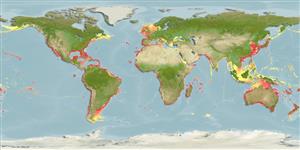Classification / Names
Common names from other countries
Main reference
Size / Weight / Age
Max length : 100.0 cm SL male/unsexed; (Ref. 2804); common length : 50.0 cm SL male/unsexed; (Ref. 7399); max. reported age: 16 years (Ref. 28725)
Length at first maturity
Lm 35.4, range 30 - ? cm
Environment
Marine; freshwater; brackish; benthopelagic; catadromous (Ref. 51243); depth range 0 - 120 m (Ref. 9321), usually 0 - 10 m
Climate / Range
Subtropical; 8°C - 24°C (Ref. 4944), preferred 26°C (Ref. 107945); 62°N - 57°S, 180°W - 180°E (Ref. 54241)
Distribution
Cosmopolitan in coastal waters of the tropical, subtropical and temperate zones of all seas. Eastern Pacific: California, USA to Chile (Ref. 2850). Western Pacific: Japan to Australia (Ref. 9812). Western Indian Ocean: from India to South Africa (Ref. 4393). Western Atlantic: Nova Scotia, Canada to Brazil (Ref. 7251); Cape Cod to southern Gulf of Mexico (Ref. 26938); absent in the Bahamas and most of West Indies and Caribbean (Ref. 7251, 9761). Eastern Atlantic: Bay of Biscay to South Africa, including the Mediterranean Sea and Black Sea (Ref. 7399). Reported in Sea of Okhotsk (Ref. 50550).
Countries | FAO areas | Ecosystems | Occurrences | Introductions
Short description
Dorsal
spines
(total): 5;
Dorsal
soft rays
(total): 7-9;
Anal
spines: 3;
Anal
soft rays: 8 - 9. Diagnosis: body stout, cylindrical in cross-section, slightly compressed; head broad and flattened (Ref. 57400). Well developed adipose eyelid (Ref. 40476, 57400) covering most of pupil (Ref. 57400). Upper lip thin and without papillae, armed with 1-6 rows of fine teeth; hind end of upper jaw reaching a vertical line from anterior eye margin; maxillary pad not visible below corner of mouth when closed; origin of 1st dorsal fin nearer to snout tip than to caudal-fin base; anterior parts and bases of 2nd dorsal and anal fins with a moderately dense coverage of scales; pectoral axillary process; 14-15 scale rows between origins of dorsal and pelvic fins (Ref. 57400).
IUCN Red List Status (Ref. 115185)
Human uses
Fisheries: highly commercial; aquaculture: commercial; gamefish: yes; bait: occasionally
Tools
Special reports
Download XML
Internet sources
Estimates of some properties based on models
Phylogenetic diversity index
PD50 = 0.5000 many relatives (e.g. carps) 0.5 - 2.0 few relatives (e.g. lungfishes)
Trophic Level
2.5 ±0.17 se; Based on food items.
Resilience
Medium, minimum population doubling time 1.4 - 4.4 years (K=0.09-0.15; tm=2-6; tmax=16; Fec=1.6 million)
Vulnerability
Moderate to high vulnerability (50 of 100)
Price category
